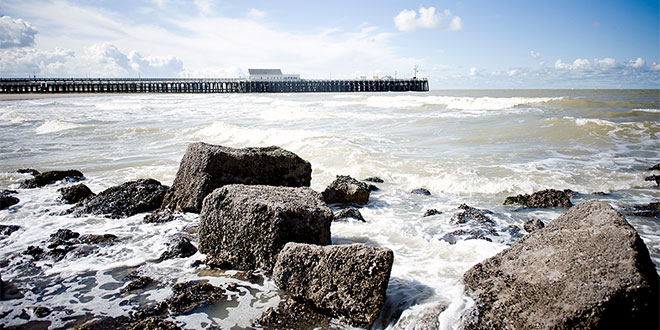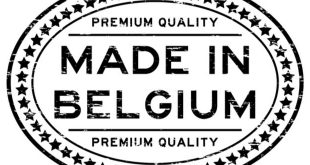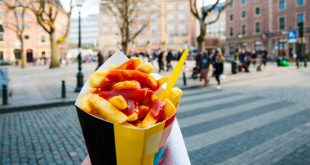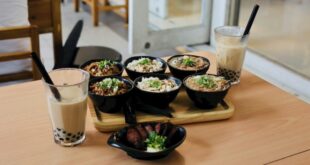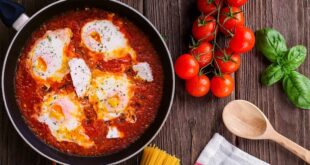Last Updated on March 22, 2023
Although Belgium is a small country, there are regional varieties in its gastronomy. Game is popular in the Ardennes, but in this post, we have a look at the most common specialities of the Belgian coastal area. By visiting coastal towns such as Oostende and Blankenberge for example, you can taste dishes that are more difficult to find in Brussels (or if you do find them in the Belgian capital), they do not have the same quality). And these are dishes you do not want to miss!
1. Paling in ‘t groen
Although you will find Paling in ‘t groen in the bigger restaurants of the coast, it actually originates from the region of the river Scheldt, roughly between Antwerp and Dendermonde. “Paling” is actually eel and “groen” means green, the main colour of the herbs used in the recipe. For this dish, pieces of 4 centimetres long of eel are simmered with a mix of herbs and vegetables, such as sorrel, sage, ginger mint, spearmint, stinging nettles, (lemon) thyme and watercress. This dish comes with French fries or bread.
The dish is not popular with everybody in Belgium though. Some people do not like the eel itself, which tends to have a lot of fish bones, while others are put off by the sauce. And still, others detest the dish as a whole. In my opinion, it is a bit of an acquired taste. So, if you happen to be an adventurous eater, go ahead and taste it!
2. Waterzooi
This is sometimes called Gentse waterzooi, referring to the city of its origin, Gent. “Zooi” comes from a dialect verb “zooien”, which means to cook, to boil and especially to cook or boil fish.
The basis of this dish is a vegetable broth with cream and egg yolk; main ingredients are chicken and/or fish, vegetables such as carrots, celeriac and leek, potatoes and herbs such as thyme, parsley and bay leaves. It is actually not a fish soup, but more of a stew. And no, this dish is not served with French fries, but usually with bread.
Waterzooi can be found in other parts of the country as well. It is one of Belgium’s most popular dishes.
3. Sole meunière/Tong in botersaus gebakken
In the article “10 Belgian Foods You Really Need to Try“, I have already spoken about the influence of French cuisine on the Belgian one. And this dish is the perfect example.
This is sole, fried in butter sauce. It used to be quite a luxurious dish and in most restaurants, you will pay about 20 euros or more. Cooks prefer to use the bigger sole for this dish and sometimes, especially in posh restaurants, they will filet the fish at your table!
TAKEAWAY: Now, a lot of people think that the bigger the sole, the better the taste. It is actually the contrary! So, if you want to recreate this dish at home, simply go to your fishmonger and ask for the smaller variety. You will pay less and enjoy their delicate taste. Another possibility is to go for another flatfish, such as lemon sole, which is widely available as well.
One more thing: sole meunière is served with French fries and a mixed salad.
4. Tong op Oostendse wijze
Another one with sole. It is indeed one of the most popular flatfish in Belgium.
This time the sole is steamed with some white wine. The filets are then served with a cream sauce, containing shrimps (almost always the small grey variant), mussels and parsley. You can find this speciality in the better restaurants along the coast. Again, this will not be the cheapest dish on the menu. On the other hand, you can easily recreate this dish at home and use a cheaper kind of flatfish.
5. Vissoep
“Vissoep” means fish soup. This is again a dish that is heavily influenced by French cuisine. At least two or three variants of fish find their way in the soup, cod and salmon being the most popular. By the way, salmon is added not only because of its taste but also because of its striking colour.
The Belgian “vissoep” tends to be different from the French bouillabaisse. There is the choice of fish, but also vegetables and herbs that differ. Belgian fish soup contains – apart from the aforementioned fish – onion, celery, carrots, leek, thyme, parsley and bay leaves. Seafood – like mussels, shrimps and scallops – is often added as well.
In a good restaurant, the fish soup will be served with slices of French bread – with or without garlic smeared on it – and a special sauce called rouille. The main ingredients are olive oil, breadcrumbs, garlic, saffron and cayenne pepper. These two side dishes really represent the French influence.
 Travel for Food Hub The Food Blog for Travel Lovers
Travel for Food Hub The Food Blog for Travel Lovers

